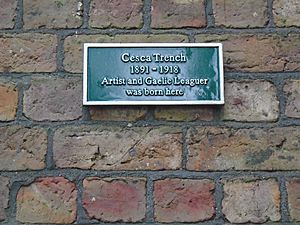Cesca Chenevix Trench facts for kids
Quick facts for kids
Cesca Chenevix Trench
(Sadhbh Trinseach) |
|
|---|---|

Plaque by the door of St John's vicarage
|
|
| Born |
Francesca Georgina Chenevix Trench
3 February 1891 |
| Died | 3 October 1918 (age 27) |
| Known for | Illustration |
| Movement | Celtic Revival |
Cesca Chenevix Trench (born February 3, 1891 – died October 30, 1918) was an artist and illustrator. She was born in Britain but became a strong supporter of Irish independence. She even adopted an Irish name, Sadhbh Trinseach.
Contents
Cesca Chenevix Trench: An Irish Artist
Early Life and Irish Roots
Francesca Georgina Chenevix Trench was born in Liverpool, England. Her family lived in the vicarage of St John the Baptist Church. She was the granddaughter of Richard Chenevix Trench, who was the Archbishop of Dublin. Cesca grew up in Kent, England.
Even though her mother supported keeping Ireland part of the United Kingdom, Cesca became an Irish nationalist. This meant she believed Ireland should be an independent country. Her uncle, Henry Butcher, was a politician who disagreed with making the Irish language a required subject in universities. This difference in opinion made them grow apart.
Becoming an Artist and Activist
From 1906 to 1908, Cesca studied at a boarding school in Malvern, Worcestershire. Here, she started to publicly support Irish Home Rule. Home Rule meant Ireland would govern itself but still be part of the British Empire.
Between 1908 and 1913, she lived in Folkestone. But every summer, she visited Ireland. She attended summer schools, especially the important Scoil Acla on Achill Island. There, she met many people who supported Irish culture and language. These included her future husband, Diarmid Coffey.
Cesca's older cousin, Dermot Chenevix Trench, also supported Irish independence. He taught her to speak Irish. Dermot encouraged her to join the Irish-Ireland movement. This group promoted buying Irish-made goods and celebrating Irish literature and art. Cesca opened an account at a shop in Dublin that only sold Irish products. She also collected Irish folklore and traditions.
Art and Political Cartoons
In October 1913, Cesca moved to Paris to study art. While there, she began drawing political cartoons. These cartoons supported the idea of Irish Home Rule. She also designed an Irish "national dress" costume.
Cesca created posters for An Claidheamh Soluis, a newspaper of the Gaelic League. This paper was edited by Patrick Pearse, an important Irish leader. She also painted scenes of Ireland. In June 1914, she returned to Dublin.
Supporting the Irish Cause
Cesca supported the Irish Literary Revival, which was a movement to promote Irish literature and culture. She joined Cumann na mBan, a women's group that supported Irish independence. Here, she learned first aid.
In July 1914, she saw the Bachelor's Walk massacre. British soldiers fired on civilians, killing three people. After this, Cesca started a new branch of Cumann na mBan in Lusk, Dublin. From July 1914 to April 1916, she worked at the Dublin Metropolitan School of Art.
The Easter Rising and Family
When World War I began in 1914, Cesca's three brothers joined the British Army. Her brother Reggie, whom she was very close to, became an officer.
On April 24, 1916, the Easter Rising began in Dublin. This was an attempt by Irish republicans to gain independence from British rule. Cesca joined other helpers in St Stephen's Green. She delivered first aid supplies to the main rebel headquarters. In her diary, she wrote that the Rising was a sad mistake.
British soldiers who fought in the Rising were from her brother Reggie's regiment. Cesca and her mother worried she might be arrested. However, she was not, even though many others were. Her brother Reggie arrived in Dublin around May 3, the day the first leaders of the Rising were executed.
Continued Activism and Personal Loss
After the Rising, Cesca kept attending Cumann na mBan meetings. She also continued to study Irish art at the National Museum of Ireland. She organized a play about Brian Boru, an ancient Irish king. She also painted murals and created Christmas cards. She became friends with Lily Yeats, sister of the famous poet W.B. Yeats.
On Saint Patrick's Day in 1917, Cesca agreed to marry Diarmid Coffey. Just three days later, her brother Reggie was killed in France during World War I. His regiment was almost completely wiped out in a German attack. Reggie left behind his wife and a baby daughter.
Despite her brother's death, Cesca and Diarmid decided to get married. Many people got married quickly during wartime. Lily Yeats helped Cesca with her wedding dress. Cesca and Diarmid married on April 17, 1918. They spent their honeymoon in the Kerry Gaeltacht, an area where Irish is still spoken.
Legacy
In October 1918, Cesca caught the severe Spanish flu. She died on October 30, 1918, at only 27 years old. Her death was a great loss to Irish art. The Gaelic League mourned her as Sadhbh Trinseach, her chosen Irish name.

